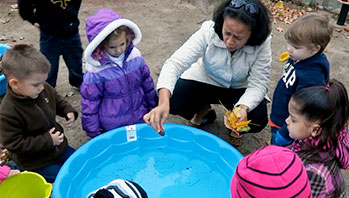- camera
- clipboard
- paper
- pen
- piece of brick
- piece of wood
- brick
- building
- materials
- wood
MA Standards:
Speaking and Listening: SL.PK.MA.1 Participate in collaborative conversations with diverse partners during daily routines and play.
MA Draft Standards:
Physical Sciences/Matter and Its Interactions: Structure and Properties of Matter/PS1.A Describe, compare, sort and classify objects based on observable physical characteristics, uses, and whether it is manufactured as part of their classroom play and investigations of the natural and human-made world.
Head Start Outcomes:
Logic and Reasoning/Reasoning and Problem Solving Classifies, compares, and contrasts objects, events, and experiences.
Science Knowledge/Scientific Skills and Method Observes and discusses common properties, differences, and comparisons among objects.
PreK Learning Guidelines:
Science and Technology/Technology and Engineering 23 Explore and describe a wide variety of natural and man-made materials through sensory experiences.
Science and Technology/Inquiry Skills 1 Ask and seek out answers to questions about objects and events with the assistance of interested adults.
English Language Arts/Language 2 Participate actively in discussions, listen to the ideas of others, and ask and answer relevant questions.
Explore Together (outdoors): Hunt for Materials

© Commonwealth of Massachusetts, Department of Early Education and Care. All rights reserved.
STEM Key Concepts: Different materials are used for making different structures and different parts of structures
ELA Focus Skills: Comparing and Contrasting, Listening and Speaking, Observing, Vocabulary
Talk about the things children have been building in the Block Center. Discuss the materials they have used to build different structures, such as ramps and tunnels.
Explain how builders use many different materials to build houses and other structures. Look at the “Houses and Buildings” display and point out different materials used in the buildings, such as brick or wood. Ask, How are all these materials the same? (they are strong) How are they different?
Hold up a brick. Ask children to turn to a partner and take turns describing the brick. Repeat with the piece of wood.
- Invite two children to come up to hold the brick. Ask the two children, How does the brick feel? Give each child a turn.
- After everyone has had a turn ask, Do you think a brick would be a good material for a building? Why or why not?
- Repeat with the piece of wood.
Then tell children they are going to go outdoors to look and feel at different materials in the neighborhood. Encourage children to record their findings by writing or drawing on their clipboards. Bring along a video camera if possble.
Take children outdoors to an area in the neighborhood where they are likely to see a variety of structures.
Encourage them to stop frequently to explore the homes, apartment buildings, shops, etc.
Let children touch the buildings. Ask them to describe the building materials. Take photographs and video of what children are noticing.
As children explore, listen and engage them when you see their interest in something. Ask questions such as,
- What do you notice about the roof on that house?
- How does the side of that building feel? What material do you think it might be made of?
Reflect and Share
Back in the classroom, talk about the discoveries children made. Use any photographs or video to help guide discussion. Ask questions such as,
- What did you notice that was similar about the material used to build the firehouse and the library?
- What was different about the material used to build the <toy playhouse> compared to the material used to build our school?
- Why do you think it would be important to make the school with heavy strong bricks?
English Language Learners: To help children grasp the concept and vocabulary meaning as you explore, you may want to point to a house and describe it together. For example, This structure is called a house. This house is made out of bricks. The bricks are strong and hard.
